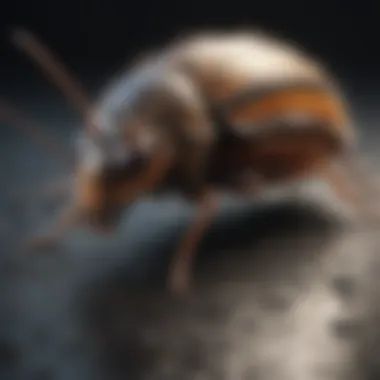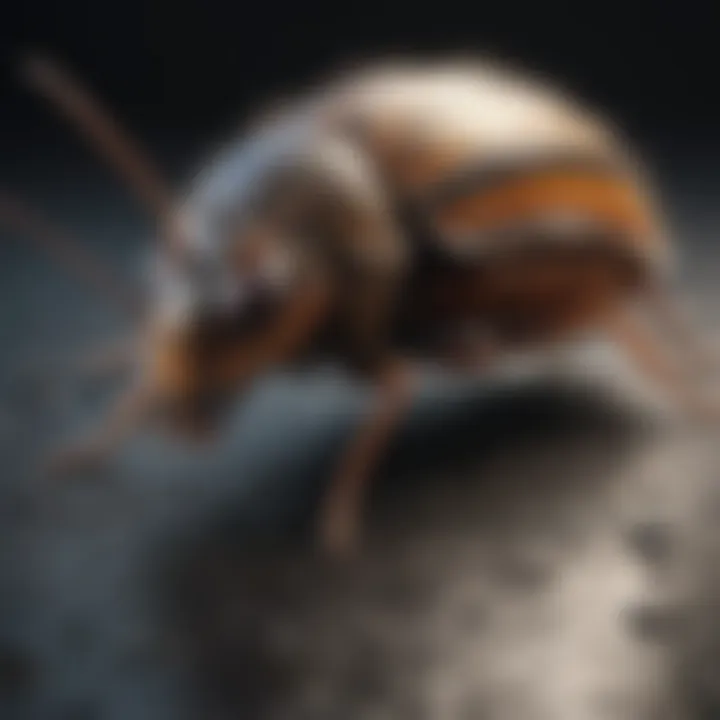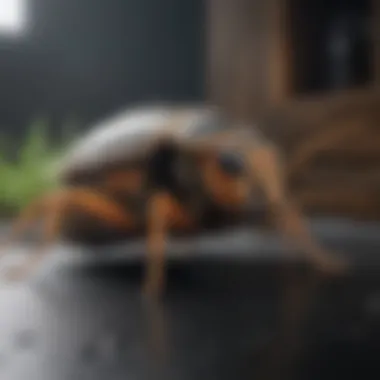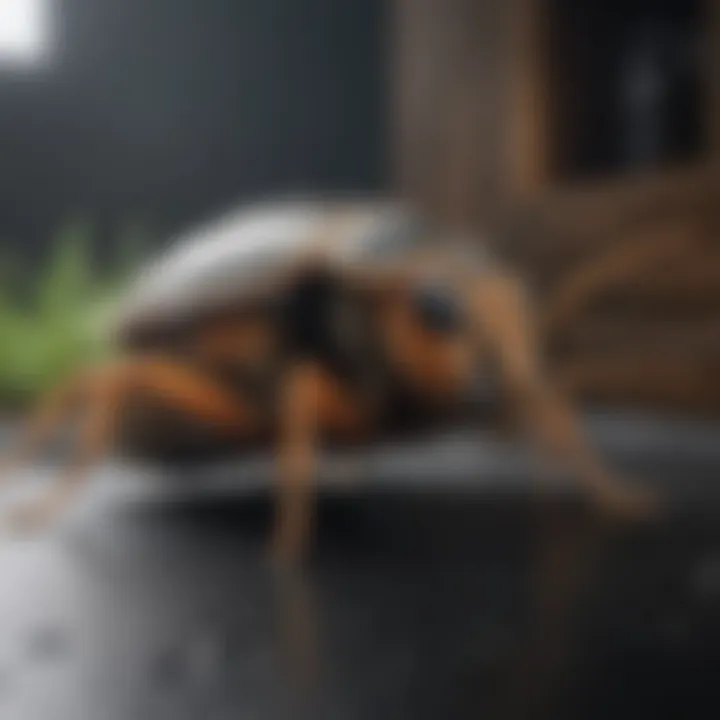Pest Control Practices and Trends in Singapore


Intro
Pest control is an essential aspect of maintaining a safe and healthy environment in Singapore. With its tropical climate, the region is home to a variety of pest species that can pose risks to public health, property, and food security. In this discussion, we will delve into the identification of common pests, explore effective prevention strategies, and analyze control methods ranging from chemical to biological solutions. By understanding these key elements, we aim to equip home owners and housewives with the knowledge necessary to manage pest challenges effectively.
Understanding the Pest
Identification
To tackle any pest problem, identification is the first critical step. In Singapore, some common pests include cockroaches, mosquitoes, and rodents. Each species has unique characteristics that help in their identification. For instance, the American cockroach is large, brown, and often found in bathrooms or kitchens. On the other hand, Aedes mosquitoes are known for their distinctive white markings on their legs and are vectors for diseases like dengue fever. Recognizing these pests is vital for effective management.
Life Cycle
Understanding the life cycle of pests offers insights into when and how they reproduce and thrive. Cockroaches, for example, can reproduce quickly, leading to an infestation in a short period. Their life cycle consists of three stages: egg, nymph, and adult. Each stage has different vulnerabilities that can be targeted using appropriate control measures. Therefore, comprehending these cycles can aid in choosing the right timing for intervention.
Pest Prevention Strategies
Environment Modification
Environment modification is a proactive strategy in pest prevention. It involves making changes to the surroundings to deter pests from invading. Some effective practices include sealing cracks in walls, removing clutter, and ensuring proper waste management. When areas are clean and free of stagnant water, it becomes less inviting for pests, reducing their presence overall.
Physical Barriers
Implementing physical barriers can also serve as an effective preventive measure. Screen doors, window meshes, and caulking gaps are some ways to reduce pest access. Additionally, using traps and bait stations strategically can help catch pests before they become a bigger issue. These measures create a physical deterrent, lowering the chances of infestations.
Control Methods
Chemical Control
When prevention strategies fall short, chemical control methods may be necessary. Various pesticides are available in the market for household use. It is crucial, however, to select products that are effective yet safe for use indoors. Always follow label instructions and consider the environmental impact of these chemicals.
Biological Control
An increasingly popular method is biological control, which involves using natural predators or pathogens to control pest populations. For example, introducing certain mites may help manage spider mite populations without harmful chemicals. This approach not only addresses the pest issue but also supports environmental sustainability.
"The approach to pest management must be multifaceted, blending prevention, intervention, and sustainable practices to safeguard health and well-being."
Prologue to Pest Control in Singapore
Pest control in Singapore is not merely a matter of aesthetics or comfort; it is essential for public health and environmental sustainability. With Singapore's tropical climate, pests such as rodents, cockroaches, and mosquitoes thrive, posing significant risks to both residential and commercial sectors. Understanding pest control is crucial for housewives and homeowners as it directly affects their living conditions. Moreover, business owners must prioritize pest control practices to protect their property and ensure compliance with local regulations.
Understanding the Pest Control Landscape
The pest control landscape in Singapore is diverse, shaped by a unique combination of climate, urbanization, and regulatory efforts. The presence of various pest species triggers the need for effective management strategies. Pest control services in Singapore are multifaceted, often incorporating chemical, physical, and biological methods. Public agencies, such as the National Environment Agency, play a vital role in monitoring pest outbreaks and enforcing regulations.
Furthermore, public awareness campaigns are crucial for educating residents about pest issues and prevention strategies. These initiatives help homeowners recognize potential problems early and understand their significance. For instance, understanding how mosquitoes breed can lead to effective prevention measures.
Importance of Pest Management
Pest management carries multiple benefits that extend beyond simply eliminating unwanted pests. Effective pest control ensures the health of individuals by reducing the risk of disease transmission, especially from insects like mosquitoes, which can spread dengue fever.
The failures of pest management can lead to severe consequences. Homes can suffer structural damage from termites or experience infestations that affect the quality of life within. Financially, the cost of pest remediation often far exceeds the investment in preventive measures.
By integrating pest control into their home maintenance routines, housewives and homeowners can safeguard their family’s health and ensure a more pleasant living space.
"Preventive measures in pest management are always more effective and less costly than reactive strategies."
In summary, pest control in Singapore is a critical aspect that addresses both safety and comfort in living and working environments. Awareness and proactive measures are essential components of successful pest management.
Common Pests in Singapore
Understanding the common pests in Singapore is crucial for effective pest management. These pests not only impact the environment but also influence human health and property. Knowledge of these pests helps homeowners implement preventative measures, minimizing the chances of infestations. As urbanization continues, the interactions between humans and pests will only increase, making this a relevant topic for every household.
Rodents: Types and Behaviors
Rodents are among the most common pests in Singapore. The two primary species seen are the black rat and the house mouse. Both can be found in various environments, from residential areas to commercial buildings.


Rodents are opportunistic feeders. They are attracted to food sources, making kitchens and pantries prime targets. They can easily adapt to city life, thriving in alleys and sewer systems. Their behavior includes gnawing through materials, which can lead to property damage and contamination of food.
Cockroaches: Identification and Habitats
Cockroaches are notoriously hard to eliminate. In Singapore, the most common types are the German roach and the American roach. The former is smaller and can be found in kitchens and bathrooms, while the latter prefers warmer areas such as basements.
Identifying cockroaches is essential. The German roach is a light brown color with two dark parallel stripes on its back. In contrast, the American roach is larger, reddish-brown, with a yellowish figure on its head. Their habitats usually include dark, moist places where they have consistent access to food and water.
Termites: Threats to Structures
Termites pose a significant threat to the structural integrity of buildings in Singapore. The most common species is the Coptotermes formosanus, known for its ability to damage wood quickly.
Termites work silently, often causing extensive damage before homeowners recognize an issue. Signs of infestation include soft, squeaky wood, mud tubes, and discarded wings. Regular checks and preventive treatments are vital to control their presence and protect property.
Mosquitoes: Health Concerns
Mosquitoes are not just a nuisance; they are vectors for diseases such as dengue fever and Zika virus. In Singapore, species like the Aedes aegypti are prevalent.
Mosquito breeding sites include stagnant water, which can be found in discarded containers, flower pots, and clogged drains. Public health campaigns focus on controlling mosquito populations through community awareness and individual measures. Understanding their breeding habits is key to reducing their numbers.
Ants: Social Structures and Types
Ants are another common pest in Singapore. Distinct types include the Singapore ant and the fire ant. These ants have complex social structures, with a clear hierarchy and division of labor, which makes eradication efforts challenging.
Ants are drawn to food sources and often invade kitchens and dining areas. Identifying the type of ant is important for effective control measures, as different species require different approaches. Homeowners should be aware of their habits, as this can inform better strategies for management.
"Understanding common pests is essential for proactive pest management and ensuring a healthy living environment. Identifying specific species allows for targeted action to protect homes and families."
Regulatory Framework for Pest Control
A robust regulatory framework is essential for effective pest control in Singapore. It establishes the guidelines and protocols that pest control operators must follow to ensure safety, efficacy, and compliance. This framework plays a significant role in protecting public health and the environment from the adverse effects of pest infestations and pest control methods.
Overview of Relevant Legislation
In Singapore, several key pieces of legislation govern pest control practices. The Environmental Protection and Management Act is one of the primary laws, addressing the management of chemical waste and pesticides. Additionally, the Pest Control Act outlines the responsibilities of pest control operators and the standards they must adhere to when dealing with different pests. Laws surrounding chemical usage, such as the Agri-Food & Veterinary Authority’s regulations on pesticides, ensure that only approved substances are used, minimizing harm to residents and the environment.
Licensing Requirements for Pest Control Operators
To operate legally, pest control companies and their technicians must obtain licenses from relevant authorities. These licenses ensure that operators possess the necessary knowledge and skills in pest management. For instance, a pest control operator must complete training programs and pass exams that cover important topics like pesticide safety and pest biology.
This licensing process not only guarantees competency but also enhances consumer confidence. Homeowners can feel secure knowing that the operators hired for pest management are qualified to handle hazardous substances properly and minimize health risks.
Compliance Standards and Best Practices
Compliance standards are integral to maintaining quality in pest control services. Operators must follow specific protocols when applying pesticides, managing infestations, and disposing of waste. Best practices include using integrated pest management techniques, which emphasize the use of non-chemical methods wherever feasible. This approach promotes sustainability and reduces reliance on chemical solutions.
Regular audits and inspections ensure that pest control operations remain compliant with established standards.
Effective compliance is key to safeguarding both public health and the environment in pest control.
In summary, understanding the regulatory framework for pest control helps house owners make informed decisions when selecting pest management services. By supporting industry regulations and compliance, they contribute to the overall safety and health of the community.
Pest Control Methods and Techniques
Pest control methods and techniques play a crucial role in managing pests efficiently. In Singapore, these strategies not only address immediate pest problems but also promote long-term solutions that are sustainable. Understanding the various pest control methods allows homeowners to choose the most appropriate measures for their needs, ensuring a safe and healthy environment. Choosing the right method can lead to effective pest reduction while minimizing risks to human health and the ecosystem.
Chemical Control: Pesticide Options
Chemical control remains a widely used method for pest management in Singapore. Pesticides can be categorized into insecticides, herbicides, and fungicides, each targeting specific pests. The importance of this approach lies in its immediate effectiveness.
- Insecticides are often used for controlling common pests like cockroaches and termites.
- Herbicides help manage weeds that can harbor pests.
- Fungicides are necessary to prevent diseases that may affect plants.
While pesticides are effective, their usage must be carefully managed. Integration of safety standards is vital to ensure minimal impact on the environment and human health. Always read and follow label instructions to prevent misuse.
Physical Control: Trapping and Barriers
Physical control involves using non-chemical methods to prevent pest infestations. This might include traps or physical barriers.


- Trapping is an effective way to monitor and reduce pest populations. For example, sticky traps can be useful for detecting insects while rodent traps are suitable for controlling mice and rats.
- Barriers such as screens, caulking, and sealing cracks can prevent pests from entering a structure.
The main benefit of this method is that it poses fewer risks to human health and the environment compared to chemical options. Blocking access points can significantly reduce the likelihood of infestations.
Biological Control: Eco-friendly Alternatives
Biological control refers to the use of natural predators or parasites to manage pest populations. This method is gaining attention as more people pursue eco-friendly alternatives.
For instance, introducing ladybugs can help control aphid populations on plants. Additionally, certain nematodes can target soil-dwelling pests in gardens. This approach not only manages pests but also maintains ecological balance.
The challenge, however, is ensuring that the introduced species do not become pests themselves. Nonetheless, biological control is a sustainable method that aligns with environmental concerns.
Integrated Pest Management: A Comprehensive Approach
Integrated Pest Management (IPM) represents a holistic strategy that combines various pest control methods. IPM takes into account the pest's life cycle, habitat, and environmental conditions. The goal is to manage pest populations while minimizing harm to people and the environment.
Key components of IPM include:
- Monitoring pest populations to determine if control is needed.
- Identifying the pest species to choose appropriate control methods.
- Implementing a combination of control methods, such as habitat modification, biological control, and chemical treatments as a last resort.
By utilizing multiple strategies, homeowners can lessen the impact of pests over the long term while reducing reliance on chemical treatments.
"Integrated Pest Management is not a single solution but a balance of multiple strategies for sustainable pest control."
Technological Advancements in Pest Control
The relevance of technological advancements in pest control cannot be overstated, particularly in a progressive urban landscape like Singapore. The integration of innovative technology in pest control practices not only enhances efficiency but also raises the standard of pest management methods available to both professionals and homeowners. As urbanization increases, the demand for effective pest management grows alongside it. Therefore, the adoption of new technologies serves as a vital component in ensuring a pest-free environment while addressing public health concerns.
Innovative Tools and Equipment
Innovative tools in pest control are evolving rapidly. These tools include high-tech devices such as thermal imaging cameras and ultrasonic repellents. Thermal imaging cameras allow pest control operators to detect pest nests and activity without disturbing the environment. This is crucial in a densely populated area where disturbance can lead to negative externalities.
Furthermore, traps equipped with sensors can monitor pest movement in real-time, providing data that leads to more tailored pest control strategies. These tools make pest management proactive instead of reactive, saving time and resources.
The Role of Artificial Intelligence
Artificial intelligence holds significant potential in transforming pest control practices. AI algorithms can analyze data from various sources, including pest sightings and environmental conditions, to predict pest population trends. This predictive ability allows pest control operators to take action before an infestation becomes critical. AI-driven tools can also enhance the efficiency of chemical application, minimizing environmental impact by ensuring that pesticides are applied only when necessary. By optimizing pest control measures, AI contributes to more sustainable practices.
Mobile Apps for Pest Identification and Management
Mobile applications have emerged as an indispensable resource for pest identification and management. These apps enable users to photograph pests and receive instant identification, along with recommended management strategies. This does not only empower homeowners but also encourages a greater understanding of pest behavior and prevention methods.
Several mobile platforms additionally offer educational content, such as seasonal pest alerts and insights into safe pest management practices. By facilitating easy access to information, these apps foster a more informed community capable of participating actively in pest management efforts.
"Leveraging technology in pest control not only ensures effective management but also enhances public health safety in urban areas."
In summary, technological advancements in pest control present an array of solutions that cater to the evolving needs of Singapore’s urban context. With innovative tools, the role of artificial intelligence, and mobile apps enhancing accessibility to information, pest management is on a path toward greater efficiency and effectiveness.
Environmental Considerations
Understanding environmental considerations in pest control is crucial in Singapore due to the delicate balance between managing pest populations and maintaining ecological integrity. This section hones in on sustainable practices and the impact pesticides can have on the local biodiversity, addressing the implications for both human health and the environment.
Sustainable Pest Management Practices
Sustainable pest management practices in Singapore emphasize the need to employ techniques that minimize ecological disruption. These practices integrate various strategies that aim to control pest populations while prioritizing environmental health.
- Cultural Controls: Altering farming techniques and landscape management can significantly reduce pest populations. For instance, rotating crops can disrupt the life cycles of pests, leading to their reduction.
- Biological Controls: Utilizing natural predators, parasites, or pathogens to combat pest populations represents an effective sustainable approach. For example, introducing specific wasp species that lay eggs in caterpillars can help manage harmful insect populations without harming the environment.
- Habitat Modification: Adjusting physical environments to make them less hospitable for pests is another sustainable method. This can involve managing moisture levels, removing standing water to control mosquitoes, or sealing entry points to keep rodents out.
These practices not only reduce reliance on chemical pesticides, but also support the health of the surrounding ecosystem. When implemented effectively, sustainable pest management can help protect beneficial species and promote biodiversity.
Impact of Pesticides on Biodiversity
The use of pesticides poses significant risks to biodiversity, raising concerns among environmentalists and public health officials. Pesticides may not only target specific pests but often affect other non-target species as well. This can lead to unintended consequences in the ecosystem.
- Direct Toxicity: Many pesticides are harmful to wildlife. Birds and beneficial insects, such as bees, can suffer from exposure, which can lead to declines in their populations and adversely affect pollination.
- Bioaccumulation: Pesticides can accumulate in the food chain. For instance, aquatic organisms might absorb pesticides washed from fields, which then affects animals higher up in the chain, including mammals and humans.
Responsible pesticide usage is vital. It’s not just about eliminating pests; it’s about safeguarding the complex web of life that supports our environment.


- Resistance Development: Continuous use of the same pesticides can lead to the development of resistant pest populations. This resistance encourages even more pesticide use, creating a vicious cycle that can escalate ecological damage.
Understanding and addressing the impact of pesticides is essential for maintaining Singapore's biodiversity. By advocating for integrated pest management strategies that combine chemical, biological, and cultural controls, it is possible to strike a balance between controlling pests and protecting the environment.
Pest Control for Businesses
Effective pest control is a cornerstone for businesses, impacting both reputation and operational efficiency. Businesses in Singapore, particularly in food service, hospitality, and healthcare, must prioritize pest management not only for compliance but also for maintaining a safe environment for employees and customers. Pests can cause significant damage to property and products, leading to financial losses and potential health risks.
The consequences of neglecting pest control can range from fines due to regulatory compliance failures to an erosion of customer trust. For the food service industry, an infestation can lead to closure and loss of revenue. Therefore, understanding the importance of pest management in commercial settings is crucial.
Importance of Pest Management in Commercial Settings
Maintaining a pest-free environment is essential for protecting public health and ensuring business continuity. Several factors highlight the significance of pest management:
- Health Regulations: Singapore has strict health codes. Non-compliance can lead to penalties and closure.
- Customer Perception: Businesses with pest issues can suffer damage to reputation. Customers are more likely to share their negative experiences online, thus affecting future business.
- Operational Efficiency: Pests can disrupt normal operations. For instance, insect damage in a warehouse can lead to costly delays.
- Profitability: Pests can lead to loss of products and increased costs. An effective pest control plan can save money long term.
In this context, it is also critical for businesses to understand the behavior and habits of common pests. Knowledge about how pests enter and thrive in commercial spaces is vital to develop prevention strategies.
Case Studies on Effective Strategies
Numerous businesses in Singapore have implemented successful pest control programs that resulted in minimized risks and optimized operations. Here are some notable examples:
- Food & Beverage Sector: One well-known restaurant chain adopted an integrated pest management (IPM) approach. This involved regular audits, proper waste management, and staff training on pest prevention. The outcome was a significant reduction in pest sightings, enhancing their public health grade.
- Hospitality Industry: A local hotel faced a severe cockroach infestation affecting customer satisfaction. After hiring a professional pest control firm, they initiated regular inspections and proactive treatments. This comprehensive strategy led to improved guest reviews and a notable increase in repeat customers.
"Effective pest management is not just about eradication; it is about prevention and practices that ensure long-term success."
To further enhance your understanding of pest management strategies, consider exploring resources like Wikipedia or Britannica for comprehensive guides.
Community Engagement and Public Awareness
Community engagement and public awareness related to pest control are pivotal components in fostering a healthier environment in Singapore. Effective pest management is not solely the responsibility of professionals; it also requires active participation from residents. When the community is informed and engaged, the overall efficacy of pest control efforts increases significantly. This section highlights the specific elements and benefits of community involvement while also considering various strategies to enhance public awareness about pest-related issues.
Educational Programs and Workshops
Educational programs and workshops serve as fundamental tools in disseminating knowledge regarding pest control. These initiatives can take various forms, such as seminars conducted by pest control experts, interactive sessions at community centers, and online webinars. The main goal is to empower householders with the necessary skills and knowledge to identify and manage pest problems effectively.
Benefits of these programs include:
- Increased awareness of common pests and their behaviors
- Instruction on preventative measures for homes
- Guidance on safe and effective pest control methods, including eco-friendly options
Additionally, workshops could be tailored specifically for different demographics, such as families, seniors, or local businesses, ensuring relevancy to their unique needs. By promoting these educational initiatives, communities can generate a proactive approach to pest management, reducing the chances of infestations.
Public Campaigns for Pest Awareness
Public campaigns for pest awareness play a crucial role in educating the wider community. These campaigns often utilize various channels to reach individuals, such as flyers, social media platforms, and community events. The primary aim is to inform the public about the risks pests pose, not only to individual homes but also to public health and the environment.
Some effective strategies for these campaigns may include:
- Engaging storytelling that illustrates pest issues
- Distribution of informative materials that detail prevention and treatments
- Collaborations with local influencers or organizations for outreach
Furthermore, campaigns should emphasize the importance of reporting pest sightings and accessing assistance through established pest control services. Successful public campaigns have been shown to create a more informed and vigilant community, which is essential in maintaining pest-free environments.
Future Trends in Pest Control
In today's rapidly evolving world, pest control practices are transforming significantly. The importance of addressing future trends in pest control lies in enhancing efficiency, increasing sustainability, and ensuring public safety. As urban environments like Singapore become even more densely populated, effective pest management becomes more crucial. Understanding these trends will equip homeowners and business operators with better tools and strategies to combat pest issues effectively.
Emerging Technologies and Their Impact
Emerging technologies are revolutionizing pest control strategies in Singapore. Innovations in monitoring systems, such as sensors and traps that use smart technology, allow for real-time detection of pest activity. For instance, companies are now deploying Internet of Things (IoT) devices that can notify pest control services at the first signs of infestation. This proactive approach minimizes response time and can significantly reduce the reliance on heavy pesticide use.
The use of drones in pest control is also gaining traction. They provide aerial surveillance to locate pest nests or outbreaks in hard-to-reach areas. Furthermore, computerized data analysis enhances precision in targeting pest species while reducing collateral damage to non-target organisms.
The Shift Towards Eco-Friendly Solutions
The shift towards eco-friendly solutions represents a significant trend in pest control. Residents are increasingly aware of the negative impacts traditional pest control methods can have on health and the environment. As a result, many are seeking alternatives that are less harmful yet highly effective.
Examples of eco-friendly techniques include the use of natural repellents and organic pesticides derived from botanical sources. Adoption of Integrated Pest Management (IPM) systems prioritizes environmentally responsible practices while ensuring pest control efficacy.
Homeowners can also implement preventive measures such as maintaining cleanliness, sealing entry points, and employing biological control methods like beneficial insects. This holistic approach not only manages pest populations but does so with minimal adverse effects.
"Investing in future pest control trends is not only about technology but also about preserving the ecosystem."
In summary, awareness of future trends in pest control in Singapore is vital. Understanding emerging technologies and eco-friendly alternatives will not only help in managing pest populations more effectively but also contribute to a more sustainable environment for future generations.







